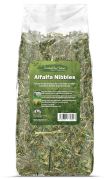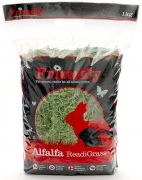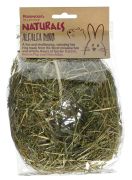A is for ... Alfalfa!
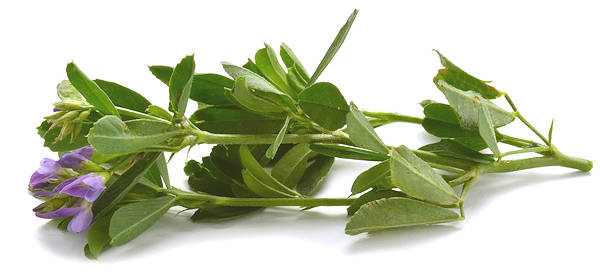
A is for …. Alfalfa!
Pronounced Al-fal-fa, and also called Lucerne, Alfalfa is loved by most rabbits, guinea pigs and other small animals and it’s nutrition-rich and high in fibre. But what is it - and why does it sometimes get a bad rap?
Alfalfa looks a little different to hay; tiny leaves all the way up a thick stem lead to a collection of purple flowers at the top - pretty!
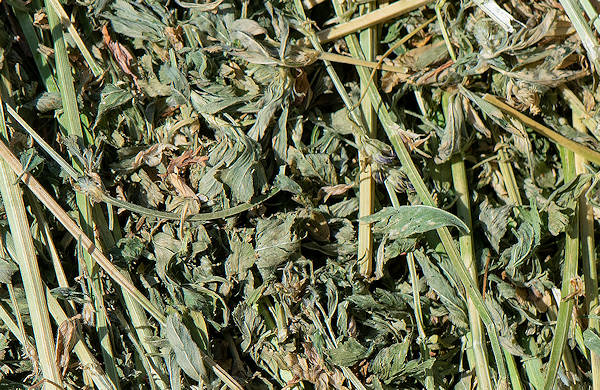
Harvested dried Alfalfa - stalky with tiny leaves
Alfalfa is often thought of as hay but it is actually part of the legume family - the same plant family that produces peas, beans and lentils! And just like these plants, Alfalfa is full of protein, as well as vitamins and minerals, such as calcium.
Alfalfa contains something in the region of around 1-2% calcium, whereas traditional hay (such as timothy, ryegrass etc) can contain around 0.3%. A big difference if you're a small animal!
This richness makes Alfalfa a perfect livestock feed, but for rabbits and other small furries it can sometimes be too rich! Just like many things in small animal world, there’s a time and a place for alfalfa, but for some it is possibly not appropriate to be fed at all.
So When Can Feeding Alfalfa Be Beneficial?
Because of its rich nutrition and high calcium, Alfalfa is perfect for the very young - it gives a wealth of valuable nutrition at their peek growing time, and it’s high calcium level is perfect for strengthening young bones!
But as rabbits are thought of as ‘adult’ in as little as 6 months, Alfalfa should not be fed in any quantity other than as a sparing treat as adulthood approaches. Apart from anything else, continuing to feed Alfalfa past this young lifestage will make a transition to hay very difficult - and as hay should be around 80% of the daily food intake, this could be a big problem and lead to many health problems later in life.
Alfalfa is also perfect for those recovering from illness, surgery or suffering from inappetence, helping to encourage eating when little ones are feeling too poorly. The rich nutritional content can help with healing, and the high fibre level good for gut health.
For the elderly, Alfalfa can be beneficial too. Often the elderly find eating less interesting, and just like humans, bone health can reduce in elderly small animals so the additional calcium can be beneficial.
And When Can Feeding Alfalfa Be Bad?
There are two main areas where alfalfa can be be a problem.
The first relates to the high nutritional levels of Alfalfa. A high nutritional intake can stimulate excess caecotroph poos in rabbits. These are the small sticky, smelly poos rabbits need to ingest for digestive health, and in a healthy rabbit with a balanced diet, their owner should never really see this type of poo.
When nutritional intake is high, there is an excess of this poo production, and rabbits only tend to eat some of this excess poo. The remainder can be stuck to fur or the environment causing a greater risk of flystrike or infection. This is true of other small animals too - including chinchillas, hamsters and guinea pigs.
The second area where feeding alfalfa can be a problem is as a result of its high calcium level.
Rabbits and some other small animals, such as guinea pigs, have an interesting way of dealing with any excess calcium they have taken in and don’t need for their body - they simply pee it out in their urine. This is all perfectly normal, and works a treat when calcium intake is only just a little more than needed.
When calcium intake is very high, as would be the case from feeding Alfalfa in anything more than a treat, this excess calcium can crystallize out in the bladder or kidney in the form of a solid (think bits of chalk in water!). These crystals can then form either a thick sludge or a stone and reduce the space available for normal urine production, causing urination issues. Ultimately a urinary infection, bladder or kidney damage can result, along with a great deal of pain. This issue can require expensive surgery to resolve.
Prevention, by dietary control, is way better than a possible cure.
So How Much Alfalfa Is OK To Feed?
Our view is that Alfalfa should only be fed as an occasional treat to healthy rabbits, guinea pigs and others.
In other circumstances, such as with the very young, old or those in recovery or in ill-health, alfalfa can be beneficial and fed in slightly bigger quantities where appropriate. However hay, such as timothy or meadow, should always remain the largest part of their diet.
We would advise against feeding Alfalfa to those with any form of kidney or urinary health issue, or those where the owner has already seen a white chalkiness in their little ones' wee - this is excreted excess calcium and a sign of an animal already managing excess calcium in their system from their diet.
And What's the Best Alfalfa to Buy?
We supply Alfalfa in several different forms to cover the different application needs that can arise:
- for treat feeding, we recommend The Hay Experts Alfalfa Nibbles - short chopped, very green and very tasty! Easy to feed a pinch or two as a lovely treat.
- For the young or elderly we recommend Friendly Alfalfa - a big bag of stemmy Alfalfa, short cut for ease of feeding, and ideal to add a burst of fibre or nutrition, as required, in an economical 1kg bag.
- Oxbow Alfalfa is also available in a 425g bag, and this tends to be the stemmiest we have available.
- The Rosewood Alfalfa Ring is also another way of providing Alfalfa, and the ring can be hung up to increase activity and enrichment.
|
A is for ... Alfalfa - Key Points:
|
We're Here to Help!
We are just a phone call or email away, and are happy to help if you have any queries or concerns about feeding Alfalfa, and with a little information about your little ones, can help you decide if it is appropriate or beneficial to feed your little ones.



